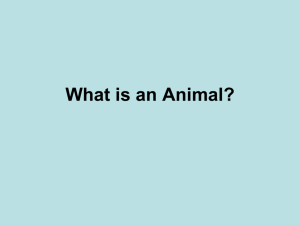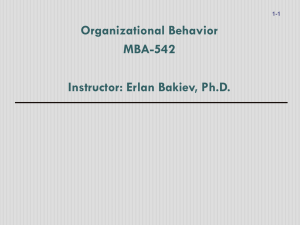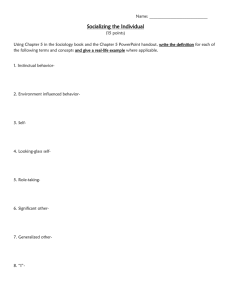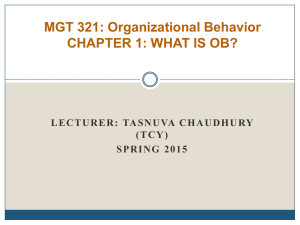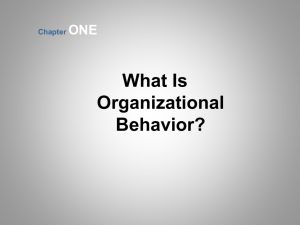Chapter 1 Organizational Behavior
advertisement
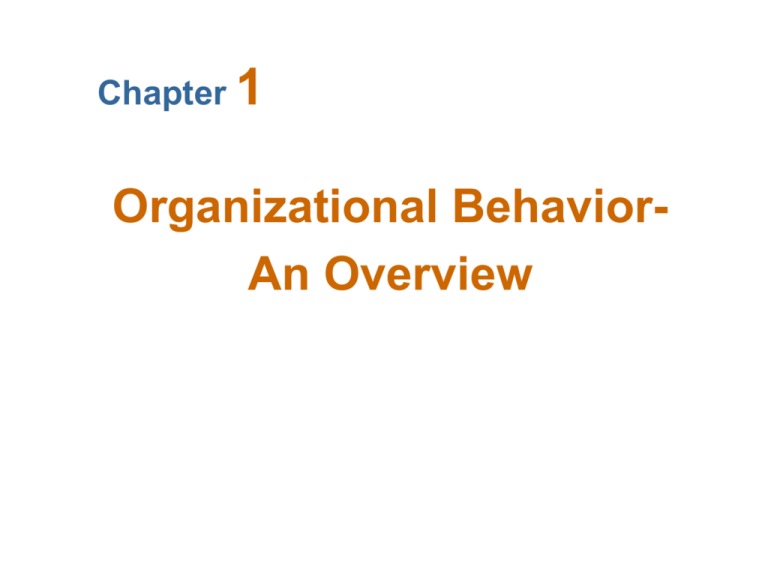
Chapter 1 Organizational BehaviorAn Overview OBJECTIVES LEARNING After studying this chapter, you should be able to: 1. Describe what managers do 2. Define organizational behavior (OB) 3. Explain the value of the systematic study of OB 4. Identify the contributions made by major behavioral science disciplines to OB 5. List the major challenges and opportunities for managers to use OB concepts Effective Versus Successful Managerial Activities (Luthans) 1. Traditional Management • Decision making, planning, and controlling 2. Communication • Exchanging routine information and processing paperwork 3. Human Resource Management • Motivating, disciplining, managing conflict, staffing, and training 4. Networking • Socializing, politicking, and interacting with others Allocation of Activities by Time Enter Organizational Behavior A field of study that investigates the impact that individuals, groups, and structure have on behavior within organizations, for the purpose of applying such knowledge toward improving an organization’s effectiveness A Systematic study and careful knowledge about people- as individual or as group- act within organization. What is OB: Complementing Intuition with Systematic Study Intuition ‘feelings’ which are not necessarily supported by research or facts. Systematic Study Looking at relationships, attempting to attribute causes and effects, and drawing conclusions based on scientific evidence. (Event Based Management) Provides a means to predict behaviors Nature of People (Fundamentals of OB) Individual Differences Perception Whole Person Motivated Behavior Desire to involve Value of person (Extracted from Organizational Behavior- Behavior at workplace by John Newstrom) Goals of Organizational Behavior Describe Understand Predict Control (Extracted from Organizational Behavior- Behavior at workplace by John Newstrom) Forces Affecting OB (Extracted from Organizational Behavior- Behavior at workplace by John Newstrom) Challenges and Opportunities for OB Responding to Globalization Increased foreign assignments Working with people from different cultures Overseeing movement of jobs to countries with low-cost labor Managing Workforce Diversity Embracing diversity Changing demographic pattern – Implications for managers • Recognizing and responding to differences Major Workforce Diversity Categories Gender National Origin Disability Age Religion Race E X H I B I T 1–4 Challenges and Opportunities for OB (cont’d) Improving Quality and Productivity Quality management (QM) Process reengineering Responding to the Labor Shortage Changing work force demographics Fewer skilled laborers Early retirements and older workers Improving Customer Service Increased expectation of service quality Customer-responsive cultures What Is Quality Management? Intense focus on the customer satisfaction Concern for continuous improvement Improvement in the quality of everything the organization does Accurate measurement Empowerment of employees E X H I B I T 1–6 Challenges and Opportunity for OB (cont’d) Improving people skills Empowering people Stimulating innovation and change Coping with “temporariness” Working in networked organizations Helping employees balance work/life conflicts Improving ethical behavior Managing people during the war on terrorism Basic OB Model, Stage I Model An abstraction of reality A simplified representation of some real-world phenomenon E X H I B I T 1-6 The Dependent Variables Dependent Variable A response that is affected by an independent variable (what organizational behavior researchers try to understand) y x The Dependent Variables (cont’d) Productivity A performance measure that includes effectiveness and efficiency Effectiveness Achievement of goals Efficiency Meeting goals at a low cost The Dependent Variables (cont’d) Absenteeism The failure to report to work Turnover The voluntary and involuntary permanent withdrawal from an organization The Dependent Variables (cont’d) Deviant Workplace Behavior Voluntary behavior that violates significant organizational norms and thereby threatens the well-being of the organization and/or any of its members The Dependent Variables (cont’d) Organizational Citizenship Behavior (OCB) Discretionary behavior that is not part of an employee’s formal job requirements, but that nevertheless promotes the effective functioning of the organization The Dependent Variables (cont’d) Job Satisfaction A general attitude (not a behavior) toward one’s job; a positive feeling of one's job resulting from an evaluation of its characteristics The Independent Variables Independent Variable The presumed cause of some change in the dependent variable; major determinants of a dependent variable Independent Variables Can Be Individual-Level Variables Group-Level Variables Organization System-Level Variables Basic OB Model, Stage II E X H I B I T 1-7
